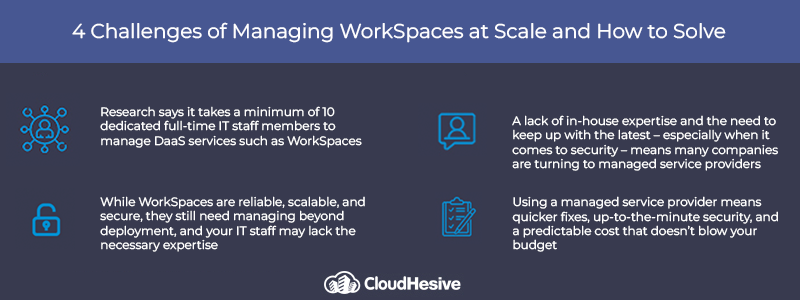A skills gap in IT staff and rising employee costs make managed services the right choice

When it comes to desktop-as-a-service (DaaS), Amazon WorkSpaces is an industry leader, offering reliable, scalable, and secure access for remote as well as in-office workers worldwide. WorkSpaces pricing is flexible, provisioning and scalability can be done quickly, and users get the same familiar experience. Adopters get enhanced security and cost savings, but the oversight required for managing WorkSpaces at scale can be challenging.
A recent survey cited unforeseen challenges and unexpected costs, created primarily by the need for a minimum of 10 dedicated full-time IT staff members to manage these systems. Some 47% of these companies used third-party implementation services, and many are finding that a managed service provider can turn around the financial equation and provide the expertise it takes for managing WorkSpaces at scale.
While WorkSpaces offer abundant advantages for companies with remote workers, they also create some unique challenges in-house IT departments aren’t generally equipped to face. Let’s explore some common challenges in managing WorkSpaces at scale and how working with a managed service provider is your best choice not only for implementation but for ongoing management.
Managing WorkSpaces at scale
Amazon WorkSpaces are easy to deploy, offer enhanced functionality with less vulnerability to downtime, and incredible scalability. But it’s not a set-it-and-forget-it proposition. To manage WorkSpaces at scale, there are things to consider going in, and things to manage after initial setup.
Planning for scaling WorkSpaces
One important setup consideration is the size of your VPC. The size of your VPC at setup is a fixed number. If you don’t set it up with adequate room for growth, you will have to tear down your directories, your WorkSpaces, and your images, create a new VPC, and start over from scratch. When you create your images, it’s important to keep track of every change, and this can be a daily chore. It’s important, though, because if your company decides to expand into another region, you’ll have to create a new image, and you’ll want to know the steps you took during setup.
4 common challenges managing WorkSpaces at scale
There are pain points on both ends – user issues and the IT manpower needed to deploy, monitor, and maintain WorkSpaces. While AWS provides a number of automated tools that help, having staff with the essential skill sets is imperative. This is why the most simple and cost-effective solution is to partner with an AWS managed services provider with qualified, certified staff who can not only solve problems but anticipate and prevent them. Here are some of the common issues that confront administrators when managing WorkSpaces at scale.
Challenge 1: Security
Amazon Workspaces is already a secure environment and provides ongoing core OS patching in a pay-as-you-go model. However, you can never have too much security. An AWS managed services partner can take your WorkSpaces environment and wrap it with security controls and management tools that increase security and help you manage it, no matter how strict your requirements.
You need control over the security of your data, the edge nodes, and the ability to monitor the activity of end-users to ensure information security. Operational control for large-scale deployments is essential and will help you pass compliance requirements such as HIPAA and PCI DSS control sets.
Challenge 2: Access control
Any user with the proper permission who logs in to your AWS account through the AWS Management Console can access your AWS resources. You might not want to provide AWS console access to the end-user or their manager.
What you need are dashboard views of your deployment, workspaces performance statistics, latency measurements, and end-user performance metrics with point-and-click features to reboot, rebuild, terminate, and perform other required maintenance functions.
Challenge 3: Printing issues
This might seem relatively trivial since digital documents prevail, but some legal documents still involve paper and ink, and other business documents such as disaster plans and anything tax-related often are printed for backup, and some employees prefer to keep paper records. This means everyone who wants to print needs to be able to.
The issue is that some users may not have printers in their WorkSpace sessions. If everyone doesn’t have the same printer – and it is likely they don’t – you must install every printer driver in WorkSpaces in order for that printer to map correctly. You’ll add as many printer drivers as you can, but every time you provision a new WorkSpace, if that user has a different printer, you’ll have to install a new driver.
The solution is a cloud printing strategy. You’ll need a cloud-native print management solution, but which one? A managed services provider with years of experience in the cloud technology space can point you in the right direction and work with your team on implementation.
Challenge 4: Budgeting
Having the requisite 10 IT professionals on your team is expensive. And what if someone leaves? It costs an average of $4,425 per hire, a vacancy costs $98 per day, and it takes about 12 weeks for your new hire to become fully productive, which is 12 weeks your other staff has to try to fill the gap. It’s likely those costs aren’t in your annual budget because they are unpredictable.
And then there’s the skills gap. The monetary losses that come from this gap are predicted to be $775 billion worldwide by the end of 2022. In 2021, the average salary for an IT professional was $120,710, not including any benefits package.
Using an AWS managed services provider means a predictable monthly cost based on a service package that meets your needs. And a managed services provider generally costs less than you would spend on one salaried employee.
A managed services provider is the smartest choice
In addition to doing the heavy lifting in the management of WorkSpaces at scale, you get 24/7 monitoring and a team of professionals with the specialized knowledge needed to solve any challenges when you use a managed services provider. Risk is mitigated, and even if you have a fully-staffed IT department, you want to optimize their use. A managed service provider can leverage platform insights to fine-tune your WorkSpaces environment for optimal value and performance.
A managed service provider can also offer business improvements beyond managing WorkSpaces at scale. They can deliver full-lifecycle solutions that reduce costs, improve your business agility, and drive the growth that fulfills your business goals.
CloudHesive’s Secure Amazon WorkSpaces solution, Centricity, allows large Amazon WorkSpaces and AppStream 2.0 deployments to be managed at scale. We’ve helped more than 100 companies reduce their operating costs and increase productivity with our focus on security, reliability, availability, and scalability. With over 30 years of experience, we leverage cloud-based technology to its full potential
We’re a cloud solutions consulting and managed service provider with expertise in all things Amazon Web Services. We have eight AWS Competencies, more than 50 AWS Certifications, membership in nine Partner Programs, and the experience and knowledge to help your business realize all the benefits of AWS cloud. Contact the CloudHesive team today.



